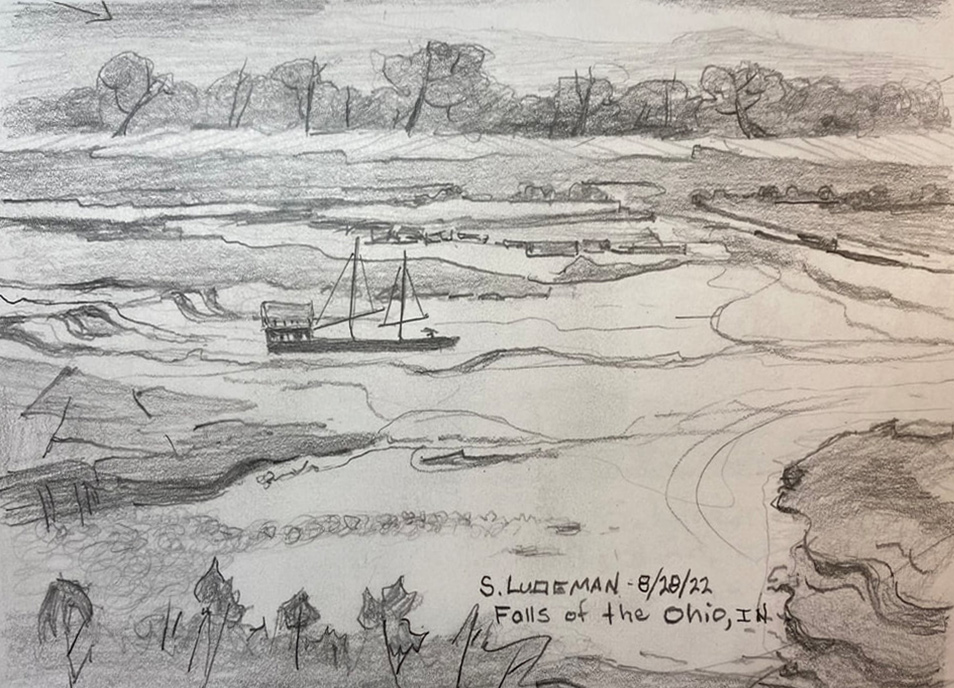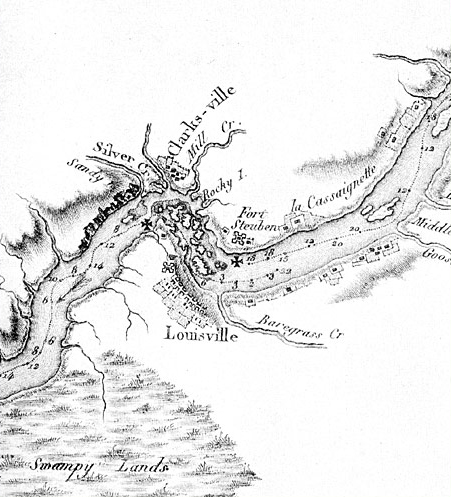Likely on this or the previous day, the expedition boats were emptied of cargo and navigated down the rapids at the Falls of the Ohio by court-appointed pilots. It is possible that the barge was damaged, a cause for delay. Also on this day, John Colter officially enlists as a private.
Falls of the Ohio
From the sketchbook of Steve Ludeman
Derived from a black and white sketch by Steve Ludeman, © 2023 www.steveludemanfineart.com. Used by permission.
Rodney’s Portage
The method of passing through the Falls of the Ohio, especially for heavy boats in low water, was to unload the cargo at Louisville’s upper landing at Bear Grass Creek. The cargo was hauled on the wagon road around Louisville to a landing below the falls (see Collot’s map on October 21, 1803). Contemporary traveler Thomas Rodney, in a letter to his son Caesar, said that they arrived at 1 pm and that “Captn. Lewis’s boat passed the Falls just before we got here.”[1]Simon Gratz, “Thomas Rodney,” Pennsylvania Magazine of History and Biography (1919), 43.2, pp. 132–134 quoted in James Holmberg, “Lewis and Clark at the Falls of the Ohio: A … Continue reading
No record of the expedition at the Falls of the Ohio are known to exist, so Rodney’s description is offered:
Mr. Shields [and] the Major went with the goods and wagon down below the Falls; and I went with the batteau, with the pilot Patton and a steerman and Buckanan, through the Falls.
—Thomas Rodney (18 October 1803)[2]Dwight L. Smith and Ray Swick, ed., A Journey Through the West: Thomas Rodney’s 1803 Journal from Delaware to the Mississippi Territory (Athens: Ohio University Press, 1997), 124.
Court-appointed, regulated pilots were hired to steer the empty crafts, usually on the Indiana side of the river which offered the deepest channel. Rodney reported, “The channel on the Kentucky shore however is now dry and the water all decends on that side of the island next to the NW shore.”[3]16 October 1803. Smith and Swick, 123.
A Dread of Wreaking
For the first time I had a dread of wrecking our boat. The rocks are so cragy, the channil so crooked, and the water so furious and rapid that it requires the utmost care and dexterity to avoid the danger. There are several islands in the Falls and a large island and several sand bars below and riffles for 2 miles below, so that indeed there is 4 miles of rapid and difficulty . . . .
We hung a minute on a rock above the brig and struck twice after but went through safe . . . .”
—Thomas Rodney (18 October 1803)[4]Smith and Swick, 125.
William Clark, a local resident at that time, was likely involved in the process of hiring a pilot and waggoneers. Pilots were licensed by the county court in Louisville. Starting in late 1803, the Indiana Territory also began licensing pilots. Two possible pilots may have been James Patton, the father-in-law of Pvt. Nathaniel Pryor, and Davis Floyd, the brother of Sgt. Charles Floyd.[5]Indiana Historical Bureau, “Lewis and Clark—Indiana Connections,” The Indiana Historian (2003), 7.
Because the captains left no journal entries during this period, we know very few details about the portage and navigation of the boats. Historian James J. Holmberg speculates that the low water precipitated navigation before the water dropped even lower. He also brings up the possibility that the expedition’s delay at the Falls of the Ohio may have been caused by the barge (called boat, barge, and bateau but never keelboat) being damaged during the descent.[6]Holmberg, “Lewis and Clark at the Falls of the Ohio: A Timeline,” 2.
Colter Enlists
In a summary of extra pay awarded the men, Clark recorded Colter’s enlistment:
We the Subscribers do acknowledge to have received of [blank] the several Sums set opposite to our names, the Same being due us from the War department pursuant to an Act of Congress bearing date March 3rd 1807, entitled ‘an Act makeing compensation to Messrs. Lewis & Clark and their companions.
. . . .
Name Period of Service Monthly Rate Amount John Colter 15 Oct. 1803 to 10 Oct. 1806 5 [$]179.33 1/3[7]Donald Jackson citing Yale University Library, New Haven, Connecticut in Letters of the Lewis and Clark Expedition with Related Documents: 1783-1854, 2nd ed. (Urbana: University of Illinois Press, … Continue reading
Experience the Lewis and Clark Trail
The Lewis and Clark Trail Experience—our sister site at lewisandclark.travel—connects the world to people and places on the Lewis and Clark Trail.
Plan a trip related to October 15, 1803:

Notes
| ↑1 | Simon Gratz, “Thomas Rodney,” Pennsylvania Magazine of History and Biography (1919), 43.2, pp. 132–134 quoted in James Holmberg, “Lewis and Clark at the Falls of the Ohio: A Timeline,” Lewis and Clark in Kentucky: Kentucky Places, www.lewisandclarkinkentucky.org/places/falls_timeline.shtml. |
|---|---|
| ↑2 | Dwight L. Smith and Ray Swick, ed., A Journey Through the West: Thomas Rodney’s 1803 Journal from Delaware to the Mississippi Territory (Athens: Ohio University Press, 1997), 124. |
| ↑3 | 16 October 1803. Smith and Swick, 123. |
| ↑4 | Smith and Swick, 125. |
| ↑5 | Indiana Historical Bureau, “Lewis and Clark—Indiana Connections,” The Indiana Historian (2003), 7. |
| ↑6 | Holmberg, “Lewis and Clark at the Falls of the Ohio: A Timeline,” 2. |
| ↑7 | Donald Jackson citing Yale University Library, New Haven, Connecticut in Letters of the Lewis and Clark Expedition with Related Documents: 1783-1854, 2nd ed. (Urbana: University of Illinois Press, 1978), 2:378. |


